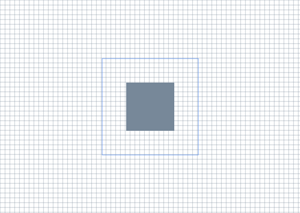Método ID2D1RenderTarget::FillRectangle(constD2D1_RECT_F*,ID2D1Brush*) (d2d1.h)
Pinta o interior do retângulo especificado.
Sintaxe
void FillRectangle(
const D2D1_RECT_F *rect,
ID2D1Brush *brush
);
Parâmetros
rect
Tipo: [in] const D2D1_RECT_F*
As dimensões do retângulo a ser pintado, em pixels independentes do dispositivo.
brush
Tipo: [in] ID2D1Brush*
O pincel usado para pintar o interior do retângulo.
Retornar valor
Nenhum
Comentários
Esse método não retornará um código de erro se falhar. Para determinar se uma operação de desenho (como FillRectangle) falhou, marcar o resultado retornado pelos métodos ID2D1RenderTarget::EndDraw ou ID2D1RenderTarget::Flush.
Exemplos
O exemplo a seguir usa um ID2D1HwndRenderTarget para desenhar e preencher vários retângulos. Este exemplo produz a saída mostrada na ilustração a seguir.

// This method discards device-specific
// resources if the Direct3D device disappears during execution and
// recreates the resources the next time it's invoked.
HRESULT DemoApp::OnRender()
{
HRESULT hr = S_OK;
hr = CreateDeviceResources();
if (SUCCEEDED(hr))
{
m_pRenderTarget->BeginDraw();
m_pRenderTarget->SetTransform(D2D1::Matrix3x2F::Identity());
m_pRenderTarget->Clear(D2D1::ColorF(D2D1::ColorF::White));
D2D1_SIZE_F rtSize = m_pRenderTarget->GetSize();
// Draw a grid background.
int width = static_cast<int>(rtSize.width);
int height = static_cast<int>(rtSize.height);
for (int x = 0; x < width; x += 10)
{
m_pRenderTarget->DrawLine(
D2D1::Point2F(static_cast<FLOAT>(x), 0.0f),
D2D1::Point2F(static_cast<FLOAT>(x), rtSize.height),
m_pLightSlateGrayBrush,
0.5f
);
}
for (int y = 0; y < height; y += 10)
{
m_pRenderTarget->DrawLine(
D2D1::Point2F(0.0f, static_cast<FLOAT>(y)),
D2D1::Point2F(rtSize.width, static_cast<FLOAT>(y)),
m_pLightSlateGrayBrush,
0.5f
);
}
// Draw two rectangles.
D2D1_RECT_F rectangle1 = D2D1::RectF(
rtSize.width/2 - 50.0f,
rtSize.height/2 - 50.0f,
rtSize.width/2 + 50.0f,
rtSize.height/2 + 50.0f
);
D2D1_RECT_F rectangle2 = D2D1::RectF(
rtSize.width/2 - 100.0f,
rtSize.height/2 - 100.0f,
rtSize.width/2 + 100.0f,
rtSize.height/2 + 100.0f
);
// Draw a filled rectangle.
m_pRenderTarget->FillRectangle(&rectangle1, m_pLightSlateGrayBrush);
// Draw the outline of a rectangle.
m_pRenderTarget->DrawRectangle(&rectangle2, m_pCornflowerBlueBrush);
hr = m_pRenderTarget->EndDraw();
}
if (hr == D2DERR_RECREATE_TARGET)
{
hr = S_OK;
DiscardDeviceResources();
}
return hr;
}
Para obter um tutorial relacionado, consulte Criar um aplicativo de Direct2D simples.
Requisitos
| Requisito | Valor |
|---|---|
| Plataforma de Destino | Windows |
| Cabeçalho | d2d1.h (inclua D2d1.h) |
| Biblioteca | D2d1.lib |
| DLL | D2d1.dll |